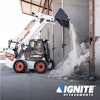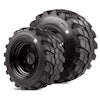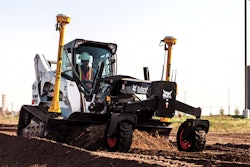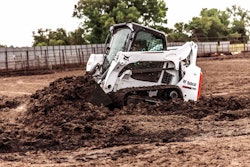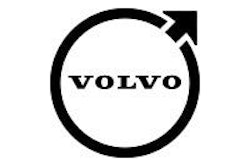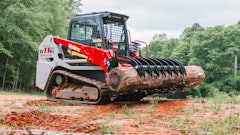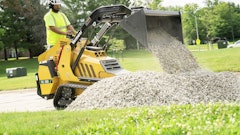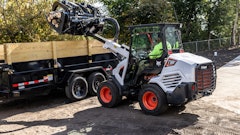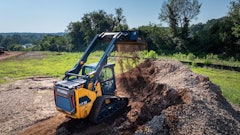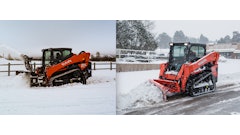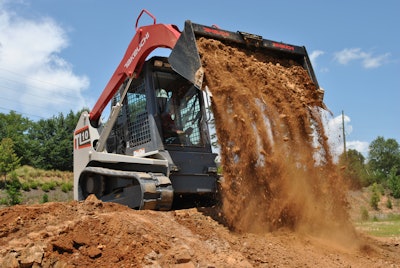
A compact track loader (CTL) can be a versatile and productive piece of equipment on a jobsite — when the right choices are made during acquisition.
“When contractors choose properly, they will have a machine with higher utilization and a higher return on investment so they can be more competitive,” says Mike Fitzgerald, loader product specialist, Bobcat. “Doing their homework by selecting the right size and style of machine, with the right accessories, can also help attract and retain good operators, which has become difficult in today’s world.”
Brian Rabe, senior product manager, skid-steer/track loaders, Gehl, suggests first evaluating your applications, taking into consideration expectations for the future.
“A clear understanding of the target applications will ultimately define how the product should be configured,” he adds. “As a quick example, a landscape contractor may require a basic unit for pallet work and general digging, loading, etc. But as the business grows, there are new opportunities for land clearing, tree replanting, etc. that can present themselves. In this case, equipping the machine… with high-flow hydraulics and a cab with an impact-resistant door is a benefit as growth occurs. It can also influence the resale value.”
Of course, budget considerations should also be at the top of the list. “Typically, the first step would be to determine what fits into your budget,” says David Steger, product manager, Takeuchi. “Then you can get into details related to specific loader features and specs that can best meet productivity requirements.”
Size Matters
Once application and budget have been thoroughly evaluated, horsepower and rated operating capacity, as well as the physical size of the CTL, come into play.
Larger and heavier CTLs typically provide greater horsepower. “When considering how much horsepower you need, take a look at the amount of material you plan to move,” advises Fitzgerald.
Rated operating capacity (ROC) is another often-evaluated spec. “To determine the correct size of machine, ask yourself how much you need to lift,” says Kevin Scotese, product manager, sales support, compact equipment, Volvo Construction Equipment. “The ROC of a machine should be 35% of its tipping load to comply with ISO 14397-1 and SAE J 818.”
Arm configuration and linkage impact lifting capabilities, with radial/radius and vertical lift path models being offered by most manufacturers. “Generally, radius lift path machines are good for ground engaging, such as backfilling trenches, while vertical lift path machines are good for lifting material into trucks and hoppers,” says Fitzgerald. “They reach a little further, and for any given size will have a larger rated operating capacity.”
While spec sheets provide all of this information, Steger recommends “test driving” a machine before making any purchase. “Spec sheets are a great place to start, but get to know each machine and how it might work into your daily routine before making any decisions.”
Overall size also matters when selecting a CTL. To determine height and width limitations for the machine, consider the working environment.
“If a contractor doesn’t select the right size of machine, he may find himself in a situation where he can’t match the needs of the jobsite,” says Fitzgerald. “For example, if you have a small machine loading into high-sided trucks, you may not have enough lift height. Or if a contractor has a large machine for moving a lot of material and he finds himself working in tight spaces with 5-ft. lot lines, he just won’t fit.”
Size and weight also affect how the machine will be transported. “Compact track loaders are moved to many different jobsites,” says Scotese. “Make sure the weight of a new purchase is within the capabilities of your current trailer.” Heavier loaders may require a CDL.
Attachments Factor Into the Equation
Attachment use plays a substantial role in determining the optimal CTL model.
“If you frequently operate attachments such as a planer, wheel saw, stump grinder or high-flow trencher, you may need a high-flow hydraulic system to match the attachment and needs for performance,” says Fitzgerald. “Using a high-flow attachment on a standard-flow machine will sacrifice performance because you don’t have enough flow to make the attachment work properly. However, if you put a standard-flow attachment on a high-flow machine and turn on the high flow, you have the potential to put too much oil to the attachment and damage it.”
A smaller horsepower machine will typically have lower high-flow settings, so you may need to move to a higher horsepower model to get the flow rates required. “Also consider that if you have smaller attachments and you want to move to a larger machine, you may need to replace the attachments, as well,” says Fitzgerald. “Not all attachments will work on all machines, so don’t assume that what you have in your inventory will fit a new machine. Work with your dealer to ensure you match any new machine purchase with attachment requirements.”
There are many attachments that function well with standard/base machines. “But it is important to understand the attachment hydraulic flow and pressure requirements, as well as how the attachment is to be controlled,” says Rabe. “Most attachments can be controlled from the standard proportional controls on the Gehl auxiliary hydraulics. A high-flow attachment may require a multi-function control for proper operation. This is available as a factory-installed option to allow total control of attachments and can be matched to attachment functions.”
Controllability and Operator Comfort
The first thing to consider when evaluating controllability and operator comfort is who will be operating the new machine. There are several different control systems available, so take into account operator preferences.
“We offer standard and advanced controls, as well as selectable joystick controls in an ISO or H-pattern,” says Fitzgerald.
The cab environment — including features such as heat and air conditioning, adjustable seats, etc. — is another important consideration. “Our seat-mounted joystick steering controls and air suspension seat are two essential items to provide precise operation, decreased operator fatigue and increased productivity,” says Rabe. “Intuitive controls allow for smoother movements with low effort and a high level of control at any engine rpm. An air suspension seat has several benefits, such as quick adjustment (including seat height) for different operators and smooth suspension action for reduced operator fatigue.”
Volvo offers optional two speed, or high speed, for roading and transporting the machine, plus offers a side entry door for easy access.
Bobcat has an engine seal kit available for applications where excessive airborne debris may be a concern, such as in brush cutting or mowing. “It seals the engine area to keep debris from getting in,” says Fitzgerald.
Other options available on Bobcat models include wide or narrow tracks and a variety of tread designs. “Narrow tracks will get you into tight spots and offer more traction because you have more pressure on the ground for pushing applications,” says Fitzgerald. “Wide tracks provide more flotation for soft ground conditions.”
Durability for Lasting Productivity
To ensure the CTL you select will provide a long, productive life, pay attention to durability features built into the machine. With CTLs, undercarriage considerations are top of mind.
“The undercarriage is where a lot of the expense is for this type of machine,” says Steger. “For optimum life, look for overall component size of the rollers and how the track frame is integrated into the main frame. We have a fully integrated undercarriage that is purpose built. It’s designed specifically for a track loader. With that, we gain ground strength and clearance, which can be important in muddy conditions where track loaders are often used. That additional ground clearance can be the difference between getting stuck or being able to continue to work and be productive.”
Gehl’s CTL range includes a dedicated chassis with an automatic track tensioning system. “The system can easily reverse tension to allow for quick track changes with minimal downtime,” says Rabe. “The tension components require no maintenance, and a measurable fuel savings is achieved by not robbing the engine of power to turn over-tensioned tracks.”
Several manufacturers also offer ride control features to reduce the amount of vibration felt by the operator and the machine. Scotese notes that Volvo’s boom suspension feature helps keep the operator from bouncing around. “It also keeps the machine from excessively vibrating, which protects components from coming loose,” he adds.
Bobcat offers a roller suspension option that minimizes vibration. “This helps the operator because it reduces fatigue by taking some of the harshness out of the ride,” says Fitzgerald. “It can affect durability, as well, by minimizing some of the vibration coming into the machine, so hoses, wiring harnesses, etc. will last longer. If you operate on rough ground a lot, it is something to consider.”

